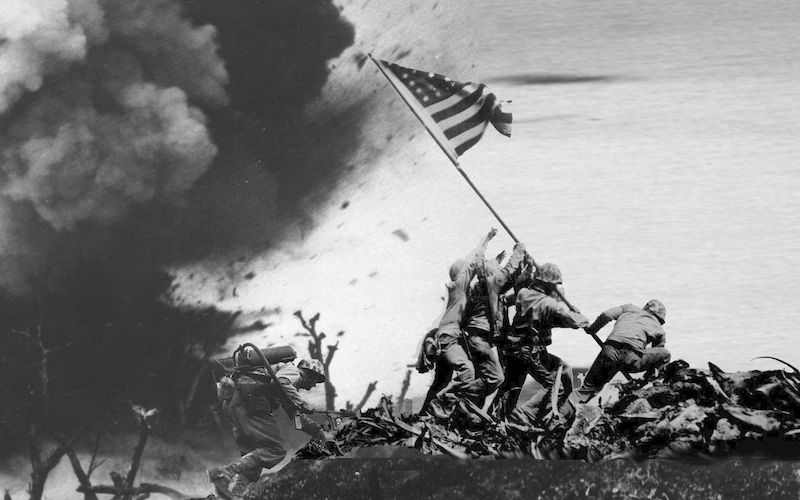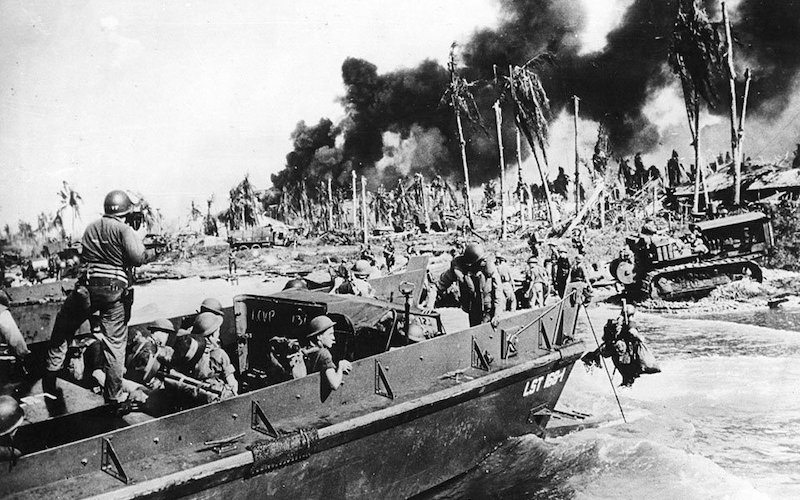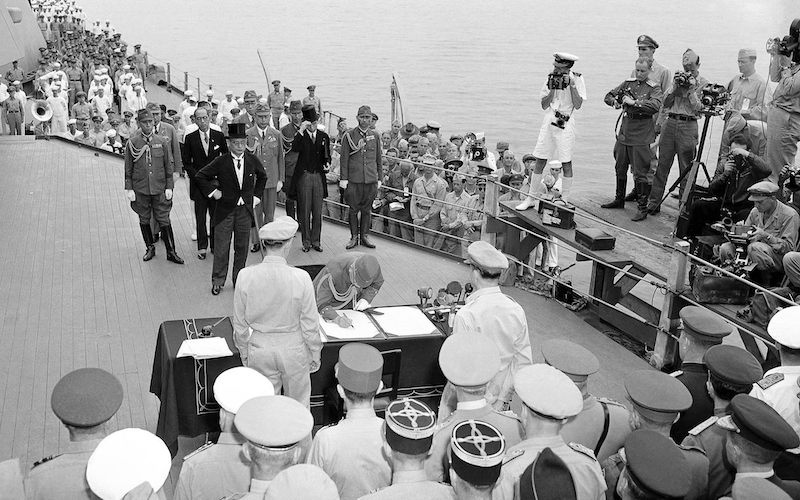
Battle of Okinawa
Prelude to the use of the atomic bomb
1 April - 22 June 1945
The Battle of Okinawa was fought between the United States of America and the Empire of Japan on the Pacific Front of the Second World War. The battle started with a US amphibious invasion of Okinawa, the largest such operation in the entire Pacific Front. The invasion took place because the Allies were planning to use the Kadena Air Base on Okinawa as a staging area for a future invasion of the Japanese Home Islands. The 82 day-long battle was one of the bloodiest in the entire war, at least on the Pacific Front, and ended in an American victory. Okinawa was occupied by the USA until 1972.

1 of 6
The island, a sixty-mile sliver of fields and mountains, lay midway between Luzon and Kyushu. Okinawa was inhabited by 150,000 people who had Japanese nationality, though they were culturally distinct from the Japanese people.

2 of 6
The surrender of Germany seemed to have had little or no effect on the Japanese, even though it meant that they would soon face the combined wrath of the Allies. (Stalin had promised at Yalta to declare war on Japan three months to the day after VE Day, and was as good as his word.) For example, while Germans were surrendering at the rate of 50,000 a month in late 1944, the Japanese were fighting on, often virtually to the last man.

3 of 6
The invasion of Okinawa had become the last in the series of operations preliminary to the assault on the Japanese home islands themselves. Planning for those supreme efforts, for which Okinawa was to provide a major base, was well under way in early 1945.
After D-Day in Normandy, the American landings on Okinawa represented the greatest amphibious operation of the war. More than 1,200 vessels transported 170,000 US soldiers and Marines of Gen. Simon Bolivar Buckner’s Tenth Army, with 120,000 more providing logistics and technical support. The island’s seizure was to be a navy-run operation, under Admiral Chester Nimitz’s auspices, though soldiers were playing a substantial role. Four divisions would make the initial assault, with three more in reserve.

4 of 6
The initial landings proved both easier and simpler than anticipated. There was practically no resistance, and the two big airfields in central Okinawa were captured on L-Day. The island was quickly cut in two, and the Marines turned north while the army divisions headed south.

5 of 6
Japanese attacks on the Allied task forces included large numbers of kamikaze, which put three American carriers out of action, and ohka bombs which proved useless when the planes carrying them were shot down. The kamikaze proved much more effective against American carriers with their thin decks than the British carriers with their heavy steel decks. The latter carried fewer planes but proved much more resistant to the planes which crashed themselves onto their superstructure.

6 of 6
Japanese attacks on the Allied task forces included large numbers of kamikaze, which put three American carriers out of action, and ohka bombs which proved useless when the planes carrying them were shot down. The kamikaze proved much more effective against American carriers with their thin decks than the British carriers with their heavy steel decks. The latter carried fewer planes but proved much more resistant to the planes which crashed themselves onto their superstructure.
The American landing on Okinawa was designed to pave the way for what threatened to be the bloodiest battle of the Asian war – invasion of the Japanese mainland. The assault that began on Easter Sunday, after days of intense bombardment, was under Admiral Chester Nimitz’s overall command. More than 1,200 vessels offloaded 170,000 soldiers and Marines of Tenth Army, while a vast covering fleet of aircraft carriers, battleships and lesser warships cruised offshore.

1 of 6
The officer commanding Tenth Army was the unimaginative General Simon Bolivar Buckner. For more than two months he conducted a campaign which seemed to its participants to be a close relative to those of the First World War in Flanders. He launched repeated frontal attacks on fixed positions which slowly gained ground, but cost heavy casualties.

2 of 6
The US Marine Corps fared no better on Okinawa than the army units to which it liked to condescend. For once, General Douglas MacArthur was probably right when he argued that the best course would be to seal off the Japanese garrison in the south of the island, leaving it to rot while US forces addressed mainland Japan.

3 of 6
The Americans expected a bitter fight and were prepared for some of it, but once again intelligence substantially underestimated the strength of the Japanese army. The new American 10th army under General Simon B. Buckner, the former commander in Alaska, was organized to control the army and marine divisions assigned to the operation.

4 of 6
A tremendous naval bombardment was to precede a four-division landing on the western beaches of central Okinawa, selected for their general suitability and proximity to two of the airfields on the island. Supported by a vast naval array and backed up by further marine and army divisions in reserve, the landing force was to seize the airfields and cut the island in two. The marine divisions would head north and the army divisions south. It was hoped that after a hard battle in the beachhead area, the attacking force could defeat the Japanese garrison in a fairly short time.

5 of 6
An enormous armada of American and British warships preceded the invasion, launching sweeping raids over southern Japan in late March 1945. Numerous Japanese planes were destroyed in the process, but others survived, having been carefully dispersed and concealed.

6 of 6
Vice-Admiral Richmond Kelly Turner’s 5th Amphibious Force was supported by Admiral Raymond Spruance’s Fifth Fleet, mustering more than forty carriers, eighteen battleships and almost two hundred destroyers. ‘We bombarded all day long,’ wrote James Hutchinson of the battleship Colorado on 31 March. ‘We fired the sixteen-inch main battery about every three or four minutes all that time. It really gets to be a strain on a person’s nerves after a while.’

Battle of Iwo Jima
During the Battle of Iwo Jima American marines landed on the island of Iwo Jima and eventually captured it from the Japanese Army.

Borneo Campaign
During the last stages of the Pacific War, Australian forces organized a series of landings on the island of Borneo. The goal of the campaign was the liberation of the island from Japanese hands.

Surrender of Japan
Our modern wars make many unhappy while they last and none happy when they are over - Johann Wolfgang von Goethe
- Andrew Roberts, The Storm of War: A new history of the Second World War, Penguin Books, London, 2009
- Gerhard L. Weinberg, A World at Arms A Global History of World War Two, Cambridge University Press, Cambridge, 1994
- Williamson Murray, Allan R. Millett, A War To Be Won Fighting the Second World War, Belknap Press, Cambridge, Massachusetts, 2000
- Max Hastings, All Hell Let Loose: The World at War 1939-45, HarperCollins Publishers, London 2011
- Max Hastings, Retribution: The Battle for Japan, 1944-45, Alfred A. Knopf, New York, 2007





